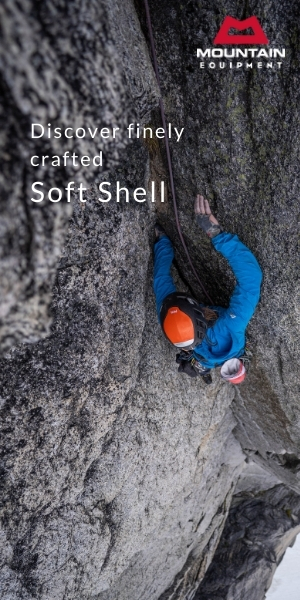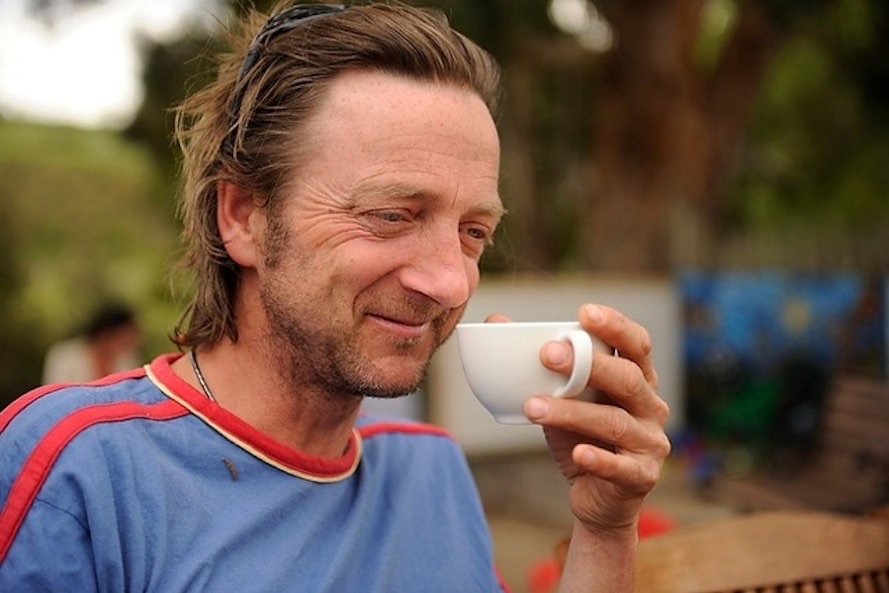Tom Ripley is an all-round climber based in Sheffield. Over many years, Tom's climbed many classic routes around the world, and has an impressive encyclopaedic knowledge of climbing. He's established a new route in Patagonia, and is part of the British Mountain Guides trainee scheme.
You've climbed hundreds of trad routes in the UK. Which stand out as being some of the best, and why?
I'd actually prefer to tell you the UK routes I’d most like to climb, or find most inspiring. The routes I’ve not done yet are unknowns, and more exciting to me. I think the beauty of living in the UK as a climber isn’t the individual climbs, but the variety of different rock types and styles of climbing available. My favourite climb would be a tricky route on Gogarth’s Main Cliff, on a sunny evening, with low tides, and an attentive belayer who's also a good friend. Or, racing up styrofoam neve in a remote, deserted Corrie, on a cloudless, windless spring day.
In answer to your original question, though, maybe Darius (E2 5c) at High Tor, as I never expected to onsight it, and in doing so I ballpointed a load of mates who are much better climbers than me.
I'd actually prefer to tell you the UK routes I’d most like to climb, or find most inspiring. The routes I’ve not done yet are unknowns, and more exciting to me. I think the beauty of living in the UK as a climber isn’t the individual climbs, but the variety of different rock types and styles of climbing available. My favourite climb would be a tricky route on Gogarth’s Main Cliff, on a sunny evening, with low tides, and an attentive belayer who's also a good friend. Or, racing up styrofoam neve in a remote, deserted Corrie, on a cloudless, windless spring day.
In answer to your original question, though, maybe Darius (E2 5c) at High Tor, as I never expected to onsight it, and in doing so I ballpointed a load of mates who are much better climbers than me.
 Tom leading above turbulent seas at Castell Helen, Gogarth. Photo: Tom Ripley Collection
Tom leading above turbulent seas at Castell Helen, Gogarth. Photo: Tom Ripley CollectionAre you enjoying the process of becoming a British Mountain Guide? What have been the challenges and highs so far?
Yes. It’s ace, but it is a long old process. Whilst I’m not the best climber in the world, I do love moving over rock and being in the mountains. Guiding allows me to maximise my time spent outside, and also to do some totally rad routes, nearly always with really nice people. Since I’ve been training to be a guide, I’ve taken clients up Poachers Falls, Centurion, The Old Man of Hoy, and the Cuillin Ridge [classic Scottish summer and winter routes]. When I first decided that I’d train to be a guide, I was working in the sales office of an outdoor brand. I hated my job and was pretty crap it. Now I love my job and I'm super motivated by it.
It’s not all smiles though; not coming from an instructional background, I found the first assessment unbelievably stressful and failed it outright. I was totally gutted afterwards, especially as it was the first time I’d worked really hard for any qualification. After another year of hard work I came back and passed. That said I wouldn’t have it any other way, as I learned heaps on both assessments. I’ve got the Scottish winter assessment coming up, and can’t wait.
Yes. It’s ace, but it is a long old process. Whilst I’m not the best climber in the world, I do love moving over rock and being in the mountains. Guiding allows me to maximise my time spent outside, and also to do some totally rad routes, nearly always with really nice people. Since I’ve been training to be a guide, I’ve taken clients up Poachers Falls, Centurion, The Old Man of Hoy, and the Cuillin Ridge [classic Scottish summer and winter routes]. When I first decided that I’d train to be a guide, I was working in the sales office of an outdoor brand. I hated my job and was pretty crap it. Now I love my job and I'm super motivated by it.
It’s not all smiles though; not coming from an instructional background, I found the first assessment unbelievably stressful and failed it outright. I was totally gutted afterwards, especially as it was the first time I’d worked really hard for any qualification. After another year of hard work I came back and passed. That said I wouldn’t have it any other way, as I learned heaps on both assessments. I’ve got the Scottish winter assessment coming up, and can’t wait.
Your new route on Aguja Bifida with Matt Burdekin seems like a cool area of the Chalten region in Patagonia. Can you tell us a bit more about it?
That was a fun trip. I first spotted the line when browsing Pataclimb, probably when I should have been revising for my finals. It was one of our plans when I first went to Patagonia with Ollie Burrows in 2013. The weather was pretty crappy that year, too snowy for rock routes, so we didn’t go near it. I returned in 2015 with Matt Burdekin and Polly Harmer. After warming up on a couple of easy things, and failing on Cerro Fitzroy a couple of times, Matt and I went for a look at Bifida, which is situated at the head of the Torre Valley. We climbed moderate rock, on mostly new ground, for two days and ended up on the summit of the peak. Chatting to Rolo Garbarotti afterwards, it turns out that we were likely only the third team to summit Bifida. The climbing was far from classic, and I wouldn’t recommend anyone goes to repeat it, but it was a great experience, and a memory I’ll treasure for a long time. I’d like to head back to Patagonia some day; Fitzroy is in my top five climbing ambitions.
That was a fun trip. I first spotted the line when browsing Pataclimb, probably when I should have been revising for my finals. It was one of our plans when I first went to Patagonia with Ollie Burrows in 2013. The weather was pretty crappy that year, too snowy for rock routes, so we didn’t go near it. I returned in 2015 with Matt Burdekin and Polly Harmer. After warming up on a couple of easy things, and failing on Cerro Fitzroy a couple of times, Matt and I went for a look at Bifida, which is situated at the head of the Torre Valley. We climbed moderate rock, on mostly new ground, for two days and ended up on the summit of the peak. Chatting to Rolo Garbarotti afterwards, it turns out that we were likely only the third team to summit Bifida. The climbing was far from classic, and I wouldn’t recommend anyone goes to repeat it, but it was a great experience, and a memory I’ll treasure for a long time. I’d like to head back to Patagonia some day; Fitzroy is in my top five climbing ambitions.
 Tom climbing Fallout Corner (VI, 7), Coire an Lochain, in Scotland. Photo: Tom Ripley Collection
Tom climbing Fallout Corner (VI, 7), Coire an Lochain, in Scotland. Photo: Tom Ripley CollectionWhat do you think about being based in Sheffield compared with North Wales?
As a climber, Sheffield is great if you want to be a real person and have a real career, but also want easy after-work access to cragging. There are just way more options: it’s a great, friendly city, and I’ve really enjoyed living there. For the full-timer who's prepared to devote their life to climbing, the eight or more different rock types within an hours drive from Llanberis give it the edge. It's also got good mountain terrain, which is what I actually miss most when living in Sheffield.
As a climber, Sheffield is great if you want to be a real person and have a real career, but also want easy after-work access to cragging. There are just way more options: it’s a great, friendly city, and I’ve really enjoyed living there. For the full-timer who's prepared to devote their life to climbing, the eight or more different rock types within an hours drive from Llanberis give it the edge. It's also got good mountain terrain, which is what I actually miss most when living in Sheffield.
If you could choose a perfect UK summer trad day, or a perfect alpine north face route, which one would you prefer?
The trad day. It would be type one fun. Alpine north faces are great, but in my experience the enjoyment is nearly all retrospective. I wouldn’t like my Groundhog Day to be on the Eiger North Face. [Type one fun is 'complete fun.' Type two is 'fun in hindsight.' Type three is never fun!]
That said, the most hedonistic days climbing I’ve had involved skiing down the Vallee Blanche, steeping out of my ski boots onto sun kissed granite, climbing a bunch of tricky pitches, before rapping off and skiing down to town for beers.
The trad day. It would be type one fun. Alpine north faces are great, but in my experience the enjoyment is nearly all retrospective. I wouldn’t like my Groundhog Day to be on the Eiger North Face. [Type one fun is 'complete fun.' Type two is 'fun in hindsight.' Type three is never fun!]
That said, the most hedonistic days climbing I’ve had involved skiing down the Vallee Blanche, steeping out of my ski boots onto sun kissed granite, climbing a bunch of tricky pitches, before rapping off and skiing down to town for beers.

Tom Ripley. Photo: Tom Ripley Collection
What happened at Gogarth with Jez when you jumped into the sea?
Ha! I knew you’d ask me about this! It’s a pretty ridiculous story.
It was early in the trad season, during my second year at Bangor University. I was unfit and probably pretty heavy. I’d spent all morning sniffing around for a climbing partner, and eventually strong-armed Jez into joining me. We drove out to Holyhead and headed down to Easter Island Gully. The plan was to do Hombre, an E1, and my limit at the time. I started up the wrong route by mistake and mantleshelfed onto a small ledge. With no good gear, unable to reverse, and unwilling to quest upwards, I was in a sticky situation. I decided to slide the rack down the rope, and my fleece and tee shirt. I then zipped my glasses into my pocket, untied and jumped (not swan dived as I’ve heard the story retold, by people who didn’t know I the protagonist) into the sea. Jez chucked me a rope and I swam to the belay. To escape and warm up I raced up a VS. Surprisingly, Jez never asked me to go climbing again.
Ha! I knew you’d ask me about this! It’s a pretty ridiculous story.
It was early in the trad season, during my second year at Bangor University. I was unfit and probably pretty heavy. I’d spent all morning sniffing around for a climbing partner, and eventually strong-armed Jez into joining me. We drove out to Holyhead and headed down to Easter Island Gully. The plan was to do Hombre, an E1, and my limit at the time. I started up the wrong route by mistake and mantleshelfed onto a small ledge. With no good gear, unable to reverse, and unwilling to quest upwards, I was in a sticky situation. I decided to slide the rack down the rope, and my fleece and tee shirt. I then zipped my glasses into my pocket, untied and jumped (not swan dived as I’ve heard the story retold, by people who didn’t know I the protagonist) into the sea. Jez chucked me a rope and I swam to the belay. To escape and warm up I raced up a VS. Surprisingly, Jez never asked me to go climbing again.
What happened when you were rescued on the Jorasses?
When I was 18 and very daft, at the end of my first alpine summer, having epic-ed my way up, or nearly up, a few things I tried to climb The Shroud on the Grandes Jorasses. I was climbing with someone I’d just met through the partners book in the Office du Haute Montagne. We’d climbed nothing of note together, but in our youthful enthusiasm we decided to try the Shroud.
Looking back, we were so out of our depth. We decide to go fast and light, only taking one rucksack between us and leaving the rest of kit in the Leschaux Hut. We got totally lost on the glacier in the dark, and ended up leading a tricky ice pitch to get back on track. Eventually we started up the Shroud, later than we’d intended, which went uneventfully, but slowly. We topped out just before dark, without much of a plan. We decided to descend the Hirondelles Ridge to the top of the Petit McIntyre and then abseil the Petit McIntyre on v-threads, which I’d heard were in-situ. We descended the ridge a short way, before finding a piece of tat. This was assumed to be the top of our descent, so we just started rapping and rapping.
After a few raps we got to the top of a steep wall. I threw the ropes. They were hanging in space, but in the half light I convinced myself they were touching down, so off I went. As I neared the bottom it became apparent that they weren't touching the ground. I tied back in and attempted to Prussik back up the ropes, a technique I was unfamiliar with at the time. After a few minutes, I gave up. At this point, I texted a friend in valley, explaining our predicament, and asking him to arrange rescue. I spent the rest of the night stood in a sling.
The next morning, as soon as dawn approached, it sounded like there were ten helicopters flying around the Leschaux Glacier. I remember thinking, “There must be a pretty serious rescue on the Jorasses, I hope the PGHM have got enough time to come and get me”!
I was still hanging in space, but spotted a small ledge that I was a couple of metres above. Using all my cunning, I abseiled down to it, and managed to swing myself onto it. My partner came and joined me, and a couple of hours later the PGHM came and whisked us away. We both were unhurt apart from frostbitten feet, and I’ll always be grateful to the PGHM for coming to get us.
When I was 18 and very daft, at the end of my first alpine summer, having epic-ed my way up, or nearly up, a few things I tried to climb The Shroud on the Grandes Jorasses. I was climbing with someone I’d just met through the partners book in the Office du Haute Montagne. We’d climbed nothing of note together, but in our youthful enthusiasm we decided to try the Shroud.
Looking back, we were so out of our depth. We decide to go fast and light, only taking one rucksack between us and leaving the rest of kit in the Leschaux Hut. We got totally lost on the glacier in the dark, and ended up leading a tricky ice pitch to get back on track. Eventually we started up the Shroud, later than we’d intended, which went uneventfully, but slowly. We topped out just before dark, without much of a plan. We decided to descend the Hirondelles Ridge to the top of the Petit McIntyre and then abseil the Petit McIntyre on v-threads, which I’d heard were in-situ. We descended the ridge a short way, before finding a piece of tat. This was assumed to be the top of our descent, so we just started rapping and rapping.
After a few raps we got to the top of a steep wall. I threw the ropes. They were hanging in space, but in the half light I convinced myself they were touching down, so off I went. As I neared the bottom it became apparent that they weren't touching the ground. I tied back in and attempted to Prussik back up the ropes, a technique I was unfamiliar with at the time. After a few minutes, I gave up. At this point, I texted a friend in valley, explaining our predicament, and asking him to arrange rescue. I spent the rest of the night stood in a sling.
The next morning, as soon as dawn approached, it sounded like there were ten helicopters flying around the Leschaux Glacier. I remember thinking, “There must be a pretty serious rescue on the Jorasses, I hope the PGHM have got enough time to come and get me”!
I was still hanging in space, but spotted a small ledge that I was a couple of metres above. Using all my cunning, I abseiled down to it, and managed to swing myself onto it. My partner came and joined me, and a couple of hours later the PGHM came and whisked us away. We both were unhurt apart from frostbitten feet, and I’ll always be grateful to the PGHM for coming to get us.

Tom enjoying standard Scottish winter conditions. Photo: Tom Ripley Collection
Follow Tom on Instagram and visit his website.
Tom is supported by Alpkit.
You can read Tom's review of the Edelrid Salathe helmet (shown in many of these photos) here.











